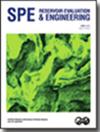RTA-Assisted Numerical History-Matching Workflow
IF 1.5
4区 工程技术
Q3 ENERGY & FUELS
引用次数: 0
Abstract
Due to strong nonlinearities in the governing diffusivity equation for flow in porous media, numerically assisted rate-transient analysis (RTA) techniques have been suggested for the analysis of multiphase production data from multifractured horizontal wells (MFHWs). However, these methods are based on some limiting assumptions that cannot be generalized for three-phase flow or when relative permeability is unknown. In this study, a new RTA-assisted history-matching technique is proposed to simultaneously match production data and diagnostic plots during the calibration process. In the proposed method, the objective function is modified to include the derivative of the integral of rate-normalized pressure for the primary phases. As such, in the history-matching process using compositional numerical simulation, the flow regimes are also matched, which can increase the reliability of the calibrated numerical model. This approach is applied to a challenging data set of production data from an MFHW completed in a Canadian shale reservoir hosting a near-critical gas condensate fluid. The results demonstrate that when the modified objective function is used, the history-matching scheme will reject models that cannot reproduce the flow regimes even if the production data are visually matched. Another benefit of this modified history-matching workflow is that, unlike other numerically assisted RTA techniques, it is not limited to any specific conceptual model or reservoir geometry. Further, interactions between parameters are accounted for during the calibration process. Including the derivative terms in the objective function can ensure a better history-matched model with improved forecast quality. However, comparing the convergence rates of the history-matching with the standard and modified objective functions indicates that adding the derivative terms comes with an additional computational cost requiring more iterations and a slower convergence rate. In this study, a modified objective function is introduced for the first time to enhance the numerical history-matching process to ensure the resulting calibrated model can also reproduce the observed transient flow regimes. This approach is easy to implement and is not limited to a specific model geometry or any input-output relationship.rta辅助的数值历史匹配工作流
由于多孔介质中流动的控制扩散方程具有很强的非线性,因此建议采用数值辅助速率瞬态分析(RTA)技术来分析多缝水平井(MFHWs)的多相生产数据。然而,这些方法是基于一些限制性假设,不能推广到三相流或相对渗透率未知的情况。本研究提出了一种新的rta辅助历史匹配技术,可以在标定过程中同时匹配生产数据和诊断图。在该方法中,对目标函数进行了修改,使其包含了初级相速率归一化压力积分的导数。因此,在组合数值模拟的历史匹配过程中,也可以匹配流型,这可以提高校准数值模型的可靠性。该方法应用于一个具有挑战性的数据集,该数据集来自加拿大页岩储层中含有近临界凝析液的MFHW。结果表明,当使用改进的目标函数时,即使生产数据在视觉上匹配,历史匹配方案也会拒绝无法再现流型的模型。这种改进的历史匹配工作流程的另一个好处是,与其他数值辅助RTA技术不同,它不局限于任何特定的概念模型或油藏几何形状。此外,在校准过程中考虑了参数之间的相互作用。在目标函数中加入导数项可以保证更好的历史匹配模型,提高预测质量。然而,将历史匹配与标准目标函数和修正目标函数的收敛速度进行比较表明,增加导数项会带来额外的计算成本,需要更多的迭代和更慢的收敛速度。在这项研究中,首次引入了一个修正的目标函数来增强数值历史匹配过程,以确保得到的校准模型也能再现观测到的瞬态流型。这种方法很容易实现,并且不局限于特定的模型几何或任何输入输出关系。
本文章由计算机程序翻译,如有差异,请以英文原文为准。
求助全文
约1分钟内获得全文
求助全文
来源期刊
CiteScore
5.30
自引率
0.00%
发文量
68
审稿时长
12 months
期刊介绍:
Covers the application of a wide range of topics, including reservoir characterization, geology and geophysics, core analysis, well logging, well testing, reservoir management, enhanced oil recovery, fluid mechanics, performance prediction, reservoir simulation, digital energy, uncertainty/risk assessment, information management, resource and reserve evaluation, portfolio/asset management, project valuation, and petroleum economics.

 求助内容:
求助内容: 应助结果提醒方式:
应助结果提醒方式:


